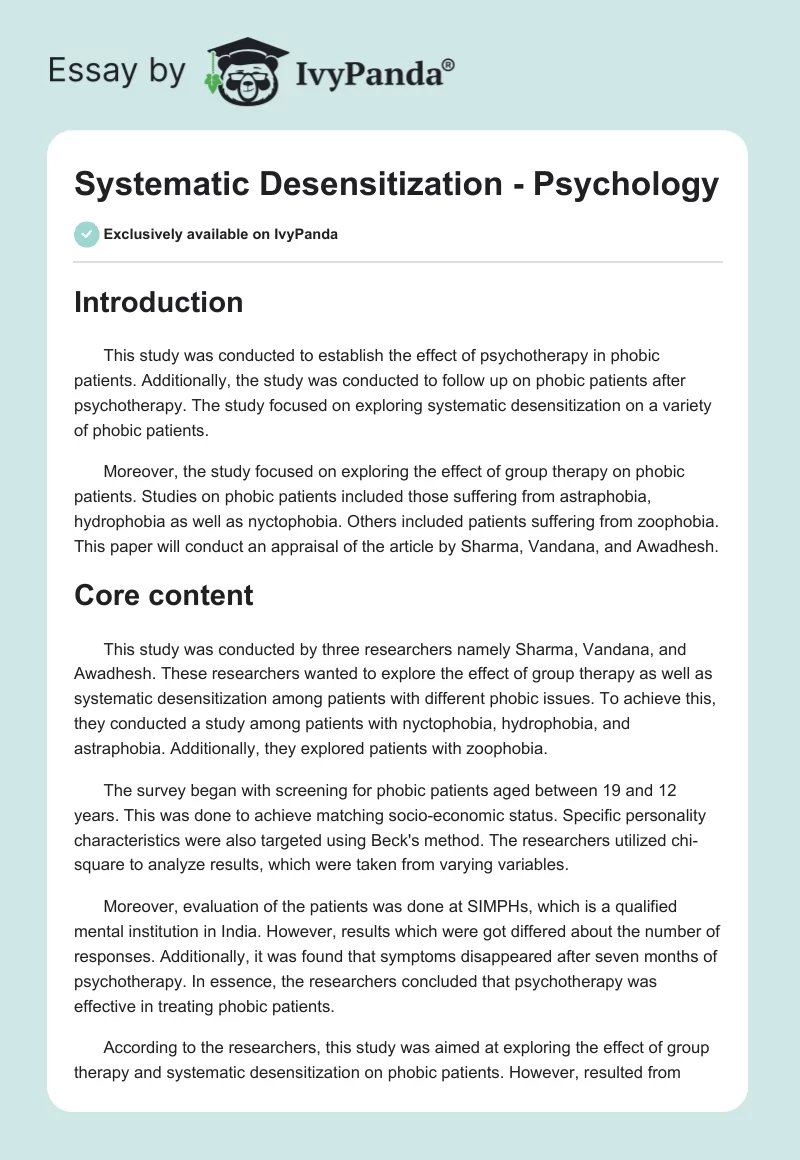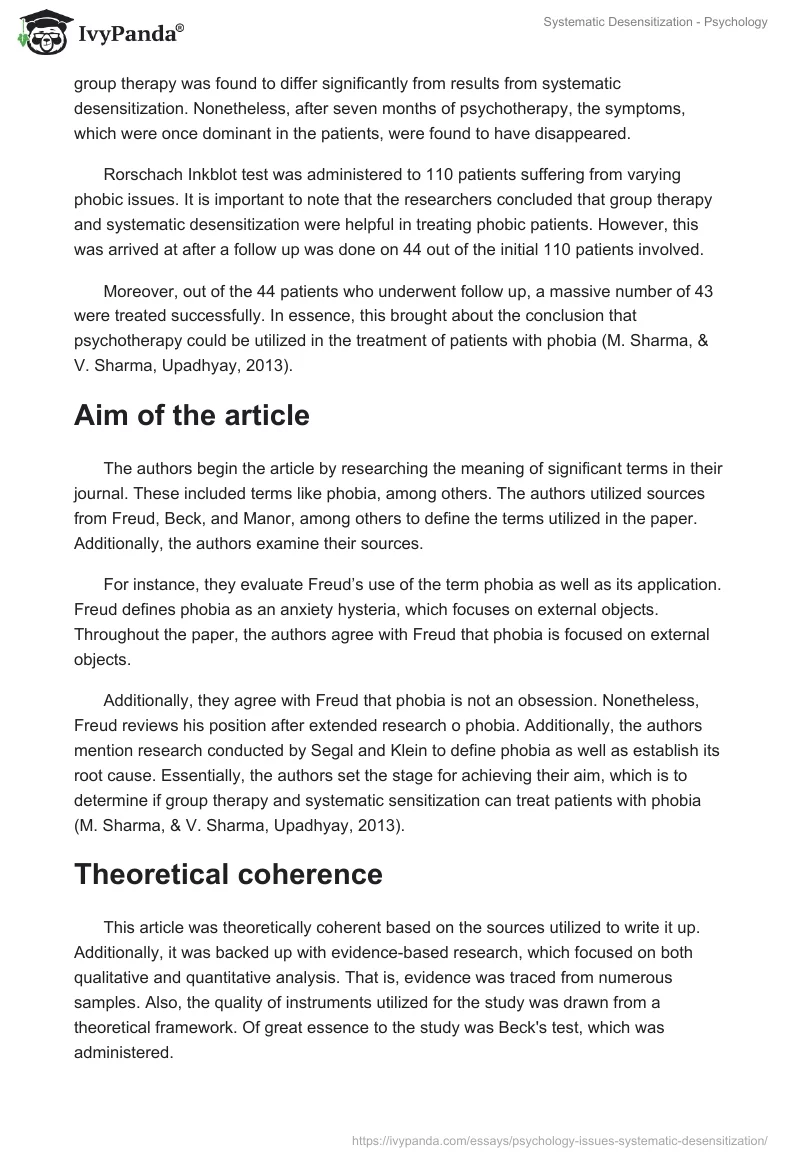Introduction
This study was conducted to establish the effect of psychotherapy in phobic patients. Additionally, the study was conducted to follow up on phobic patients after psychotherapy. The study focused on exploring systematic desensitization on a variety of phobic patients.
Moreover, the study focused on exploring the effect of group therapy on phobic patients. Studies on phobic patients included those suffering from astraphobia, hydrophobia as well as nyctophobia. Others included patients suffering from zoophobia. This paper will conduct an appraisal of the article by Sharma, Vandana, and Awadhesh.
Core content
This study was conducted by three researchers namely Sharma, Vandana, and Awadhesh. These researchers wanted to explore the effect of group therapy as well as systematic desensitization among patients with different phobic issues. To achieve this, they conducted a study among patients with nyctophobia, hydrophobia, and astraphobia. Additionally, they explored patients with zoophobia.
The survey began with screening for phobic patients aged between 19 and 12 years. This was done to achieve matching socio-economic status. Specific personality characteristics were also targeted using Beck’s method. The researchers utilized chi-square to analyze results, which were taken from varying variables.
Moreover, evaluation of the patients was done at SIMPHs, which is a qualified mental institution in India. However, results which were got differed about the number of responses. Additionally, it was found that symptoms disappeared after seven months of psychotherapy. In essence, the researchers concluded that psychotherapy was effective in treating phobic patients.
According to the researchers, this study was aimed at exploring the effect of group therapy and systematic desensitization on phobic patients. However, resulted from group therapy was found to differ significantly from results from systematic desensitization. Nonetheless, after seven months of psychotherapy, the symptoms, which were once dominant in the patients, were found to have disappeared.
Rorschach Inkblot test was administered to 110 patients suffering from varying phobic issues. It is important to note that the researchers concluded that group therapy and systematic desensitization were helpful in treating phobic patients. However, this was arrived at after a follow up was done on 44 out of the initial 110 patients involved.
Moreover, out of the 44 patients who underwent follow up, a massive number of 43 were treated successfully. In essence, this brought about the conclusion that psychotherapy could be utilized in the treatment of patients with phobia (M. Sharma, & V. Sharma, Upadhyay, 2013).
Aim of the article
The authors begin the article by researching the meaning of significant terms in their journal. These included terms like phobia, among others. The authors utilized sources from Freud, Beck, and Manor, among others to define the terms utilized in the paper. Additionally, the authors examine their sources.
For instance, they evaluate Freud’s use of the term phobia as well as its application. Freud defines phobia as an anxiety hysteria, which focuses on external objects. Throughout the paper, the authors agree with Freud that phobia is focused on external objects.
Additionally, they agree with Freud that phobia is not an obsession. Nonetheless, Freud reviews his position after extended research o phobia. Additionally, the authors mention research conducted by Segal and Klein to define phobia as well as establish its root cause. Essentially, the authors set the stage for achieving their aim, which is to determine if group therapy and systematic sensitization can treat patients with phobia (M. Sharma, & V. Sharma, Upadhyay, 2013).
Theoretical coherence
This article was theoretically coherent based on the sources utilized to write it up. Additionally, it was backed up with evidence-based research, which focused on both qualitative and quantitative analysis. That is, evidence was traced from numerous samples. Also, the quality of instruments utilized for the study was drawn from a theoretical framework. Of great essence to the study was Beck’s test, which was administered.
Additionally, the paper was written logically. Since the paper was scientific and peered reviewed, it was structured in a professional manner. For instance, the authors began by defining phobia as well as by giving both primary and secondary sources for further research in psychotherapy.
Notably, key points in the article were stressed to help in understanding. It can be noted that the authors utilized different sources to ensure that theoretical coherence was achieved. Moreover, the sources were credible and dependable in psychotherapy (M. Sharma, & V. Sharma, Upadhyay, 2013).
Methodology
The author’s utilized different methodologies in arriving at their conclusion. It can be noted that the authors utilized a combination of methodologies to work on their study. For instance, the authors began by listing various treatments for phobia. This was followed by a discussion on systematic desensitization as well.
In the end, the authors discussed group therapy. These discussions set the stage for practical on the two methods of psychotherapy. According to this research, 110 patients suffering from phobia were selected. They underwent screening, which showed that the authors wanted to ensure that only the right persons were explored. The 110 patients were placed in two broad groups namely the untreated and the treated.
Moreover, they established that patients with phobia had it for at least three years. The methodology utilized was systematic and specific to the topic of discussion. Notably, the methodology applied was so detailed that everything relating to theoretical framework had to be included (M. Sharma, & V. Sharma, Upadhyay, 2013).
Relevance to clinical practice
The article is highly relevant to clinical practice. This is evident in the fact that psychotherapy can be conducted on individuals with a phobia as well as other ailments with the hope of achieving positive results. Psychotherapy in the article can also be applied in other areas o psychology such as cognitive behavior therapy, gestalt therapy, and behavioral therapy, among others. Behavioral therapy is very good as it helps to restructure jointly held beliefs of the family.
This is advantageous to families as it promotes unity and strength. The therapeutic process is also important as it works to promote mutual respect between the therapist and client as they collaborate for a common purpose. However, the process is quite difficult on resistant individuals as well as those who are stereotyped on certain beliefs (Yalom & Lescz, 2005).
Group therapy is applicable in healthcare because it helps patients to recover from diseases such as phobia, among others. Gestalt therapy is most applicable in a group context. This is mainly because it emphasizes on direct actions and experiences. This is especially good for clients in a group context that experience anxieties concerning future events as this can be enacted at present. Also, this approach would fit multicultural clients if the therapy were used to integrate polarities in clients.
Moreover, the therapist should accept his/her client’s culture for success. Gestalt approach is very important as it stresses the client’s awareness of the present environment to establish his/her next move.
This is very helpful as one can only change his/her behavior if he/she understands himself/herself. The approach is quite difficult when working with culturally reserved clients as they become resistant. However, the approach is good in terms of its analysis of present situations as opposed to past occurrences (Yalom & Lescz, 2005).
Another method mentioned in group therapy is behavior therapy. Techniques involved in behavioral therapy include behavioral and psychoanalytic techniques, among others. Also, the approaches involved include acceptance based and mindfulness approaches, among others. Other techniques used include relaxation training, applied behavioral analysis, multimodal therapy, systematic desensitization, self-modification programs, eye movement reprocessing and desensitization, exposure therapies and social skills training, among others.
The behavioral approach is widely used due to its numerous techniques and methods. This allows it to be applied in many problems, which range from anxiety to group problems, among others. Also, it is well placed to work in people from diverse cultures due to its uniqueness.
Moreover, the therapist is expected to be creative to adapt to any type of client. Based on the above facts alone, it can be noted that the authors’ research made a great impact in clinical practice because the article introduced cheaper was of treating phobia in patients. Moreover, this research paper gave an insight into numerous applications in clinical practice (B. Sadock & V. Sadock, 2007).
Conclusion
This article was well research since it had resources from credible scholars like Segal, Klein, and Freud, among others. Moreover, the study was conducted based on known theoretical frameworks. It is also worth noting that the analysis of the paper was done in an effective manner using chi-square. This reflected the fact that the article was credible and reliable based on its outcomes. Additionally, the article proved that group therapy and systematic desensitization were effective in treating patients with a phobia.
Recommendations
As much as this article was well-researched and documented, it also opened avenues for further research. For instance, it would be recommendable that the researchers advance further and examine the reasons why the two outcomes differed. Additionally, it would be important to ensure that follow up is done on all participants for minority views be taken in too. Additionally, the authors should give a detailed comparison between group theory and systematic desensitization outcomes.
References
Sadock, B. & Sadock, V. (2007). Kaplan and Sadock’s Synopsis of Psychiatry: Behavioral Sciences/Clinical Psychiatry. New York, NY: Lippincott Williams & Wilkins.
Sharma, M., Sharma, V., & Upadhyay, A. (2013). Effect of Psychotherapy in Phobic Patients and Their Follow-up. SIS Journal of Projective Psychology & Mental Health, 20(1) 36-41.
Yalom, I. & Lescz, M. (2005). Theory and Practice of Group Psychotherapy (5th ed.). New York, NY: Basic Books.


